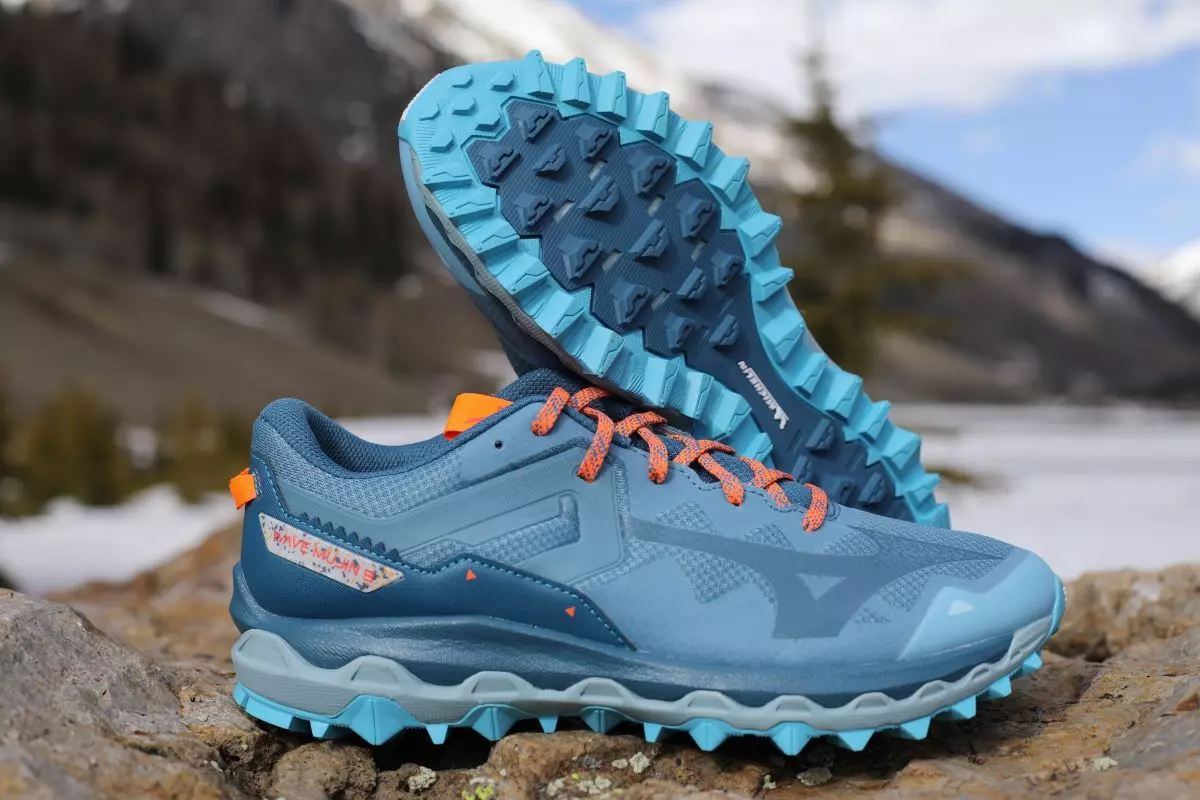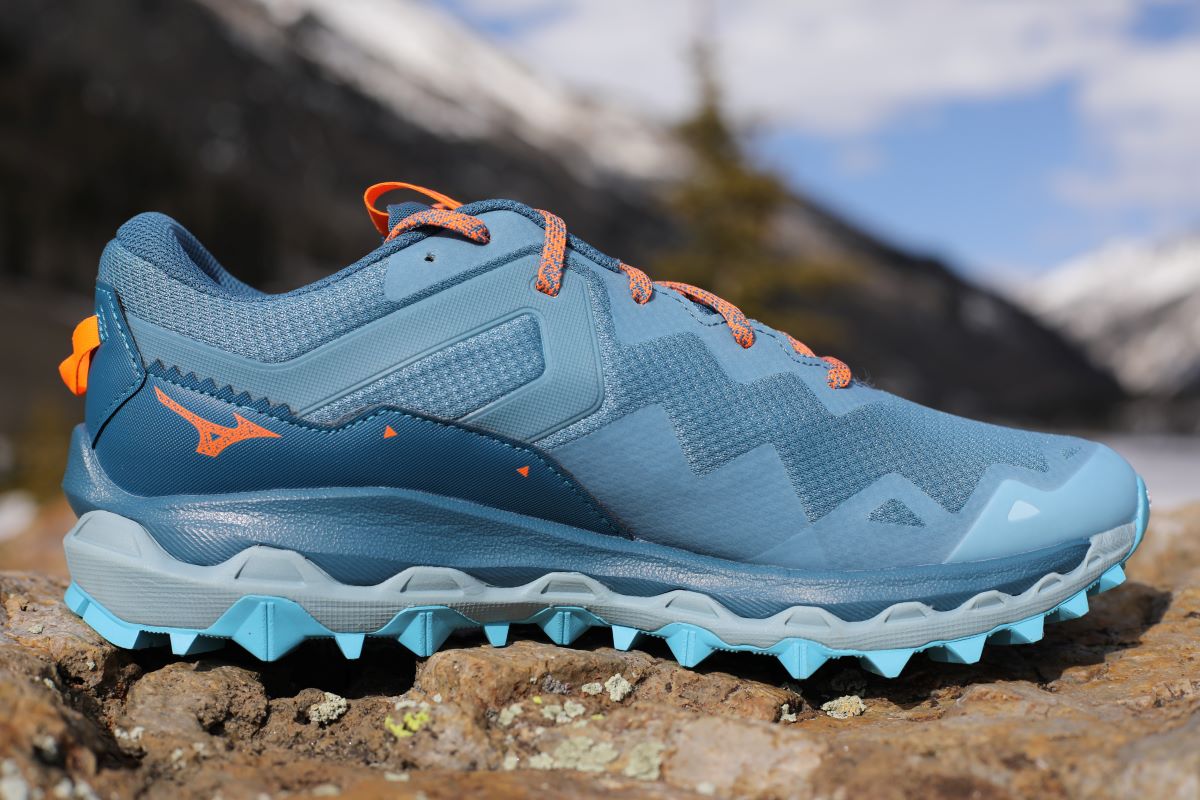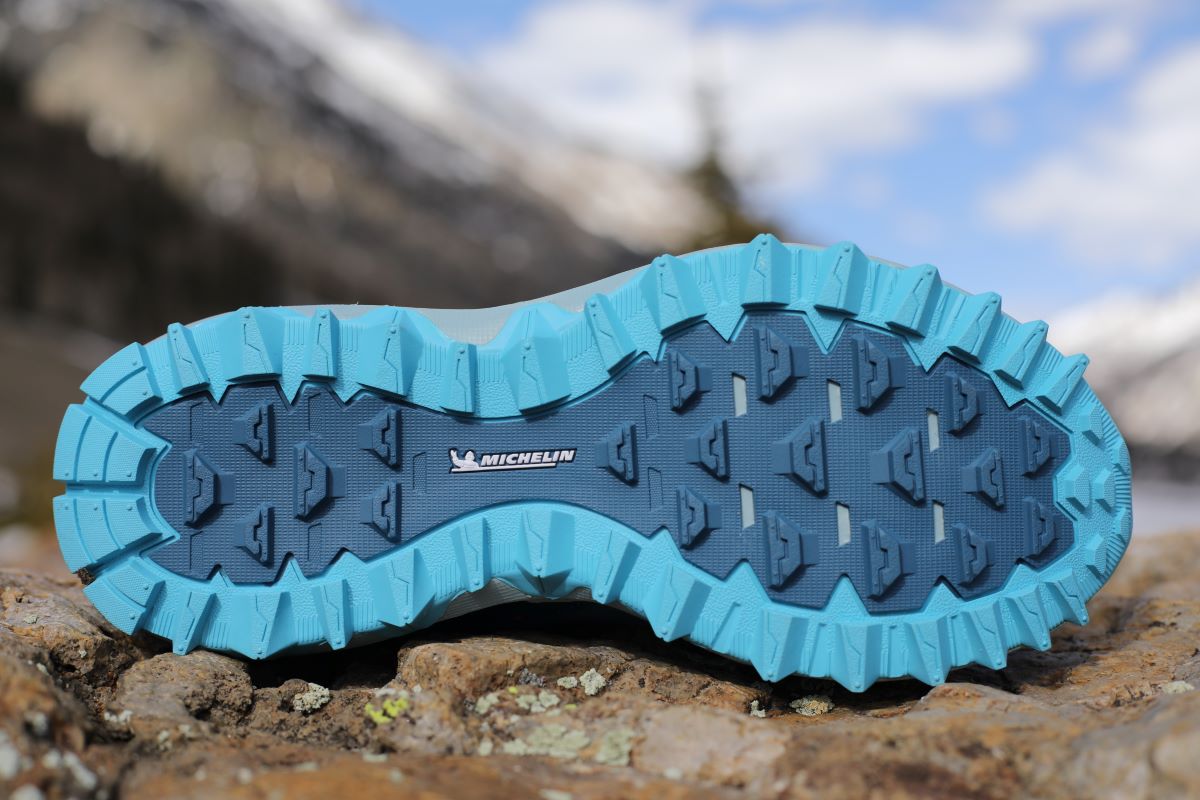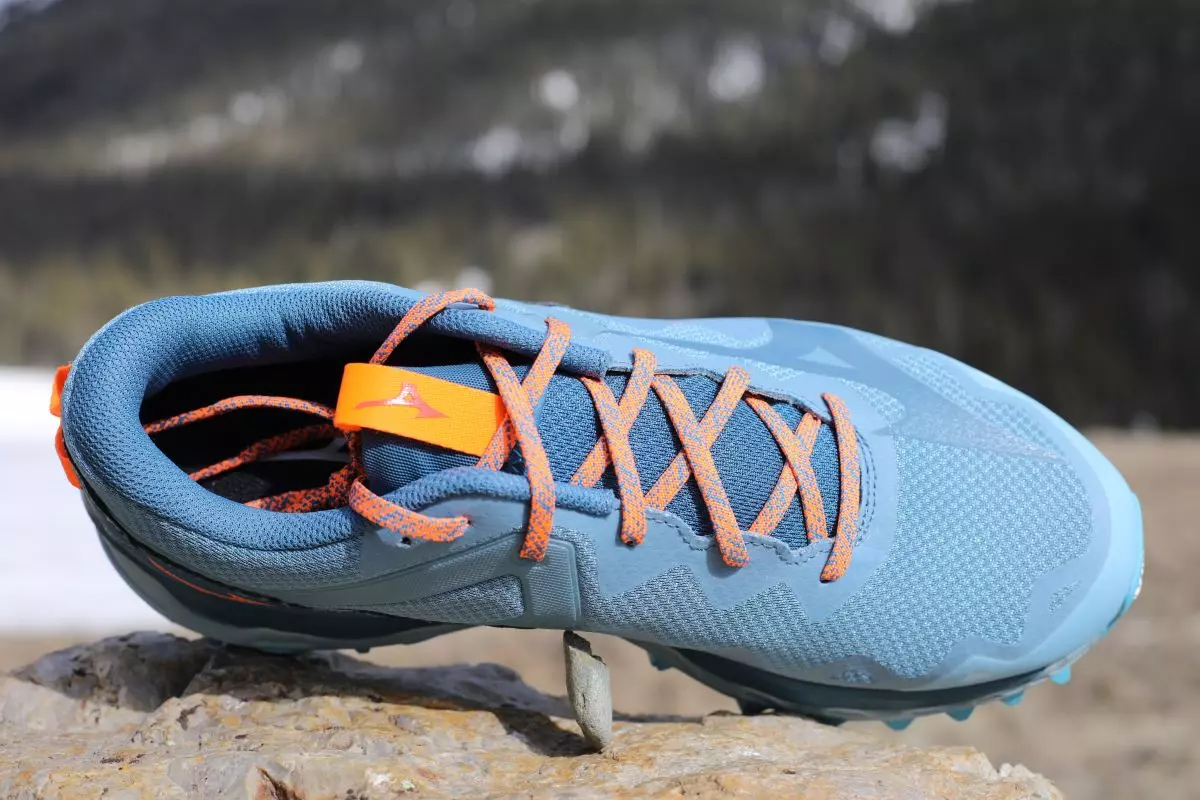When I think of the Mizuno brand, I think road shoes or apparel and equipment for ball sports, but the Mizuno Wave Mujin 9 ($150) is a worthy trail running shoe for its traction alone. I really appreciated the firm and speedy ride of the various renditions of Mizuno Wave Riders when I ran roads in the late 1990s through 2012. Once I switched over to primarily trails, my preferred shoe brands changed as well. But this winter, I had my first experience with this true trail shoe from Mizuno, and the Wave Mujin 9 impressed.
The Mizuno Wave Mujin 9 is a neutral 10-millimeter drop shoe with 28-millimeter stack height in the forefoot and 38-millimeter stack in the heel and a fairly average actual weight of 12.2 ounces (347 grams) for the men’s size 9. The ride is on the firm side of cushioned, and the well-lugged sole provides excellent protection from pointy rocks. While this shoe really excels in traction and underfoot protection, especially for snowy and muddy conditions, I’m not sure it’s truly a long-distance shoe. Runs up to about 12 miles in length felt fine for my feet and legs, but beyond 16 miles, the firmness seemed to exact a toll.
The aggressive tread and somewhat weather-resistant upper makes it similar to other shoes currently on the market, like the Salomon Speedcross 6, — here’s our Salomon Speedcross 6 review — the Saucony Peregrine 12 — check out our Saucony Peregrine 12 review — or perhaps even the Brooks Cascadia 16 — yep, of course we’ve got a Brooks Cascadia 16 review for you as well.
I’ve found the upper to be a little wider and more accommodating than the Speedcross 6, the drop higher and more comfortable for me than the Peregrine 12, and the shoe more nimble-feeling than the Cascadia 16. The traction is nearly comparable with the Speedcross 6 — which I’ve certainly put to the test this winter — but with more volume through the upper. It may appeal to those for whom the Speedcross 6 is just too snug. The shoe also works well, without pinch points, when paired with microspikes from various brands — which is a plus for when toothy traction is required.
The Mizuno Wave Mujin 9 is billed as a true trail running shoe for the neutral runner, and this edition is the lightest version yet. Mizuno also notes the shoe’s eco-friendly focus, with 90% recycled material. It comes in both women’s and men’s fit, and for this review, I tested the women’s shoe in a size 9.5. This is on par with my sizing in La Sportiva, Brooks, and New Balance, and a size bigger than I wear in Salomon.
Shop the Women's Mizuno Wave Mujin 9Shop the Men's Mizuno Wave Mujin 9
Mizuno Wave Mujin 9 Upper
The Mizuno Wave Mujin 9 upper is constructed from an engineered mesh that resists water and debris so well that I had to double check to see if it had an extra weatherproof aspect. The breathability is adequate for the winter running I’ve been doing, but I haven’t been able to test it above 65 degrees Fahrenheit because of the type of winter we’ve had. The water resistance is so effective, however, that if I truly soak the shoe — hello, crazy winter trail conditions and flowing streams and water-covered trails in Arizona Rim Country — it takes a few days for them to truly dry, even with the help of newspapers stuffed inside. On the flip side, two-plus hour runs on Colorado packed-snow trails with occasional postholes still result in dry shoes within 24 hours.
The upper has a more accommodating shoe-like fit compared to the soccer-boot style of other aggressive traction shoes like the Salomon Speedcross 6, so people with higher-volume feet may find this to be a more comfortable option. Accommodating doesn’t mean sloppy, however. Thermoplastic Polyurethane (TPU) overlays along the medial and lateral aspects of the upper provide lightweight support and structure through most of the upper.
The forefoot is well protected with the thin overlying rand, such that the occasional toe stub is a non-issue. Further foot security is provided by the stiff, substantial heel cup and well-padded ankle collar, which keeps my foot snugly on the shoe platform even with side slopes or the wild, wonky frozen prints and ruts that are all too common in winter running. The heel could almost feel overbuilt if your trails are smooth and tranquil, but I appreciate the structure as I tackle the rocky, highly variable trails or the snowy and icy ones, depending on location and conditions.
The partially gusseted tongue is padded just enough to protect the top of the foot from the wide, flat laces, which stay tied as long as you give your double knot an extra-strength pull. A small lace garage sits atop the tongue near the ankle, which I never feel the need to use. Webbing loops on the tongue and at the back of the heel assist with pulling the shoe on and off and make it easy to hook the shoes to the outside of your gear bag with a carabiner after a sloppy run.
Mizuno Wave Mujin 9 Midsole
Mizuno employs their proprietary Mizuno Enerzy foam in the midsole on the Mizuno Wave Mujin 9, which is touted a being lighter and more cushioned than prior versions. While this shoe does feel more cushioned than the current Mizuno Wave Rider 26 road shoe, and I feel it’s a bit more cushioned than the Salomon Speedcross 6 over shorter runs, it still has a relatively firm feel compared to the Brooks Cascadia 16 or the whole range of more cushioned trail shoes out there. And stated above, the resilience seems to fade, and the cushioning gets flat soon after about 16 miles of running and my feet and legs really start to feel the pounding. It bounces back by the next day, but it definitely wouldn’t be a trail marathon or ultramarathon shoe for me.
Though there is no mention of a rock plate, the two layers of Wave midsole technology, coupled with the outsole, provide excellent rock protection. I’ve had zero issues with rock bruises or even discomfort from rocks, branches, or other pointy incursions.
Mizuno Wave Mujin 9 Outsole
Instead of the more common Vibram or brand-specific outsole compound, Mizuno uses Michelin rubber in the outsole of the Mizuno Wave Mujin 9 to create the 4-millimeter lugs of varying shapes, heights, and patterns to great success. With at least 200 miles on them, the outsole has no obvious wear and sticks very well to rough granite, wet rocks and roots, snow, gravel, dirt, and hardpack wintery mix, while still sloughing off most mud and wet dirt exceptionally well. It’s one of the two outsoles I have preferred for my true-winter-conditions running this season and yet the lug pattern still lends itself well to smooth and comfortable strides if a few miles of dry dirt are inserted in the midst of a more technical, snowy, or sloppy run.
I found the heel-toe transition very comfortable for my slow- to moderate-speed runs, which is all I do when the conditions require shoes with significant traction anyway. I also tested them on a few powerhikes with long climbs in dry conditions, where they worked beautifully as well. All in all, this is a terrific outsole, which really adds to the value and performance of the shoe.
Mizuno Wave Mujin 9 Overall Impressions
I’ve been really pleased with the Mizuno Wave Mujin 9 and its performance as an aggressive-traction, shorter-distance trail running shoe. In my experience, the outsole rivals the best brands and shoes I’ve had a chance to run in, and the more accommodating shape and fit of the upper may allow a wider variety of feet to be comfortable and secure.
However, for a true long-distance or ultra shoe, it falls short with the dropoff in midsole cushioning comfort and resilience beyond 16 miles. This is the only disappointing aspect of the shoe for me, and it definitely limits the usability if you’re trying to limit the number of trail shoes in your collection. I’d love to see Mizuno improve the midsole for the next release to bring it up to the level of a true long-distance trail shoe.
Shop the Women's Mizuno Wave Mujin 9Shop the Men's Mizuno Wave Mujin 9
Call for Comments
- Have you tried the Mizuno Wave Mujin 9?
- Did it work well for you?
[Editor’s Note: If you’re affiliated (i.e., an employee, ambassador, etc.) with a brand, please share your relation in each of your comments on this article. Thanks!]





